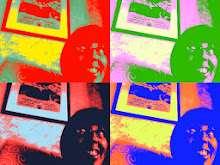What would my design philosophy look like?
I wish we had tools and resources that invited us to play with them, to joyfully discover new possibilities with them. So I very much favor form and function over strict utilitarianism, strict minimalism, or strict anything for that matter.
In my aesthetic universe, beauty is a reward for everyone who encounters it and harmonizes with its expression. Of course we don't all agree about what is beautiful. If we did agree, what would we deem "art," and what would we not categorize as art? Surely not only works that are aesthetically pleasing, and surely not exclusively works that are disturbing or perturbing, shocking or simply unexpected.
I like things that tell you how to use them, or that fulfill a need I hadn't thought of but wished I had. When Apple makes iTunes unfathomable to someone who hasn't been steeped in Apple's design and user experience world for decades, I feel a sort of double betrayal. I feel the "You said this was going to be easy" whine pushing me downslope as if I was trying to climb up scree so loose I wound up churning my legs and landing below where I'd started. Apple products all looks so clean and so good but sometimes you can't find what you need on those smooth, blank surfaces.
Color makes my world go around (or 'round, more musically speaking). I can think of no reason I would not wear or use fabrics and paints in bold, vibrant colors. Color adds something unique to the atmosphere. Perhaps you could get some of the same benefits from a constant parade of fresh flowers arranged everywhere. I remember feeling shock at the beauty of the tall, dramatic, gladiola-centric bouquets artfully arranged throughout my grandfather's formal dining room and living room because I knew they seldom used those spaces and most people hardly saw them. Did they receive the same kind of arrangements through the winter? I'm sure their florist provided them with seasonally appropriate bouquets, but how many people enjoyed their bright colors? So I share the wealth and try to dress colorfully, to cheer up me and everyone else around me.
I wish we had tools and resources that invited us to play with them, to joyfully discover new possibilities with them. So I very much favor form and function over strict utilitarianism, strict minimalism, or strict anything for that matter.
In my aesthetic universe, beauty is a reward for everyone who encounters it and harmonizes with its expression. Of course we don't all agree about what is beautiful. If we did agree, what would we deem "art," and what would we not categorize as art? Surely not only works that are aesthetically pleasing, and surely not exclusively works that are disturbing or perturbing, shocking or simply unexpected.
I like things that tell you how to use them, or that fulfill a need I hadn't thought of but wished I had. When Apple makes iTunes unfathomable to someone who hasn't been steeped in Apple's design and user experience world for decades, I feel a sort of double betrayal. I feel the "You said this was going to be easy" whine pushing me downslope as if I was trying to climb up scree so loose I wound up churning my legs and landing below where I'd started. Apple products all looks so clean and so good but sometimes you can't find what you need on those smooth, blank surfaces.
Color makes my world go around (or 'round, more musically speaking). I can think of no reason I would not wear or use fabrics and paints in bold, vibrant colors. Color adds something unique to the atmosphere. Perhaps you could get some of the same benefits from a constant parade of fresh flowers arranged everywhere. I remember feeling shock at the beauty of the tall, dramatic, gladiola-centric bouquets artfully arranged throughout my grandfather's formal dining room and living room because I knew they seldom used those spaces and most people hardly saw them. Did they receive the same kind of arrangements through the winter? I'm sure their florist provided them with seasonally appropriate bouquets, but how many people enjoyed their bright colors? So I share the wealth and try to dress colorfully, to cheer up me and everyone else around me.

